
Microseris nutans is a species of flowering plant in the family Asteraceae known by the common name nodding microseris. It is native to western North America, including southwestern Canada and much of the western United States, including the Sierra Nevada in California, where it grows in many types of habitat.

Triteleia lilacina, the foothill triteleia, is a monocot flowering plant in the genus Triteleia.
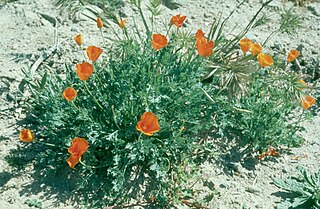
Eschscholzia lemmonii is a species of poppy known by the common name Lemmon's poppy.

Allium tuolumnense is a rare species of wild onion, known by the common name Rawhide Hill onion.
Balsamorhiza macrolepis is a species of flowering plant in the tribe Heliantheae of the family Asteraceae, known by the common name California balsamroot. It is found only in California, where it grows in dry, open habitat, mostly in mountainous areas, mostly in the western foothills of the Sierra Nevada and in the eastern Coast Ranges near San Francisco Bay. It is now becoming rare in the Coast Ranges.

Chlorogalum grandiflorum is a species of flowering plant known by the common name Red Hills soap plant. It is endemic to the Sierra Nevada foothills, such as the Red Hills, of California, where it grows in chaparral, woodland, and forest.
Eryngium pinnatisectum is an uncommon species of flowering plant in the family Apiaceae, known by the common names Tuolumne eryngo and Tuolumne button celery.
Microseris bigelovii is a species of flowering plant in the family Asteraceae known by the common name coastal silverpuffs. It is native to the west coast of North America, where its range extends from the southern tip of Vancouver Island to the northern coast of California.
Microseris campestris is a species of flowering plant in the family Asteraceae known by the common name San Joaquin silverpuffs. It is endemic to California, where it grows in the San Joaquin Valley and adjacent Sierra Nevada foothills, and the central California Coast Ranges. It is a resident of grassland and open slope habitats, sometimes near vernal pools.

Microseris douglasii is a species of flowering plant in the family Asteraceae known by the common name Douglas' silverpuffs. It is native to western North America from Oregon and California to Baja California. It grows in several types of habitat, including grassland and vernal pools, and on soils containing clay and serpentine.

Microseris elegans is a species of flowering plant in the family Asteraceae known by the common name elegant silverpuffs. It is native to California and Baja California, where it grows in the valleys, foothills, and coastal mountain ranges. Its habitat includes grassland, sometimes near vernal pools, and especially clay soils.
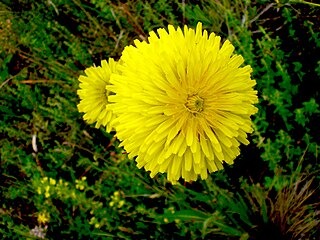
Microseris laciniata is a species of flowering plant in the family Asteraceae known by the common name cutleaf silverpuffs. It is native to the western United States from Washington to northern California and Nevada, where it grows in forest and grassland habitat.
Microseris paludosa is a species of flowering plant in the family Asteraceae known by the common names marsh silverpuffs and marsh microseris. It is endemic to California, where it has a scattered distribution between southern Mendocino and northern San Luis Obispo Counties, mainly near the coast. Its habitat includes coastal scrub and grassland and coniferous forest.

Microseris sylvatica is a species of flowering plant in the family Asteraceae known by the common names sylvan scorzonella and woodland silverpuffs. It is endemic to California, where it has a scattered distribution throughout the central California Coast Ranges and inland mountain ranges, including the Sierra Nevada of the state. Its habitat includes grassland and openings in wooded areas.
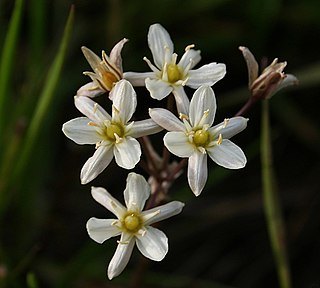
Muilla maritima is a species of flowering plant known by the common names sea muilla and common muilla. It is native to California and Baja California, where it grows in many types of habitats from the coast to the Mojave Desert and Sierra Nevada foothills and other inland mountains, in grassland, woodland, desert, and forest floras. It is a perennial plant growing from a corm and producing an erect flowering stem up to half a meter tall. The onion-like leaves at the base of the stem may be 60 centimeters long. The flowering stem bears an umbel-shaped array of many flowers on pedicels up to 5 centimeters long. Each flower has six tepals which are green-tinged white in color with brownish midribs and no more than 6 millimeters in length. At the center of the flower are six erect stamens with blue, green, or purplish anthers.

Rudbeckia californica is a species of flowering plant in the family Asteraceae, known by the common name California coneflower.
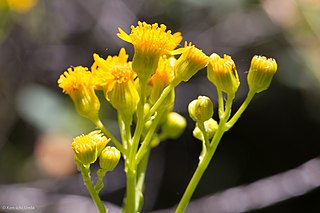
Packera clevelandii is an uncommon species of flowering plant in the aster family known by the common name Cleveland's ragwort. It is endemic to California, where it is known from only two small regions, a section of the North Coast Ranges around Napa County and a part of the Sierra Nevada foothills on the opposite side of the Sacramento Valley. The plant grows in shrubby chaparral on serpentine soils.
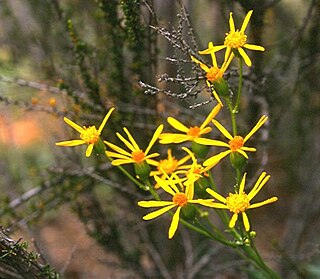
Packera layneae, known by the common name Layne's ragwort and Layne's butterweed, is a rare species of flowering plant in the aster family.
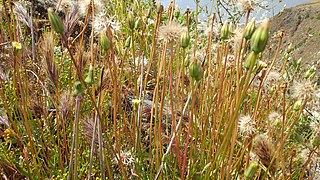
Microseris heterocarpa, known by the common name grassland silverpuffs, is a species of flowering plant in the family Asteraceae.

Stephanomeria lactucina is a species of flowering plant in the family Asteraceae known by the common names lettuce wirelettuce and woodland wirelettuce. It is native to Oregon and California, where it grows in coastal and inland mountain ranges, including the Sierra Nevada. It can be found in many types of habitat, including coniferous forests. It is rhizomatous perennial herb producing a slender, erect stem reaching 30 to 60 centimeters in maximum height. The linear or lance-shaped leaves are up to 8 centimeters long and their edges are lined with widely spaced teeth. Solitary flower heads occur on erect peduncles. Each head contains up to 10 ray florets, each with an elongated tube and a fringed pink ligule roughly a centimeter long. The fruit is an achene tipped with a spreading cluster of long, plumelike pappus bristles.














